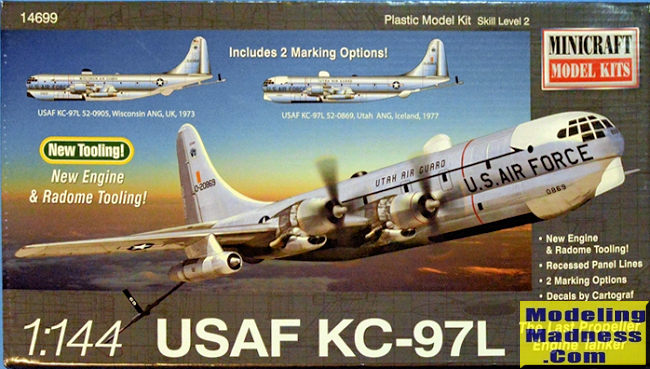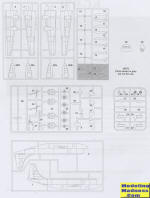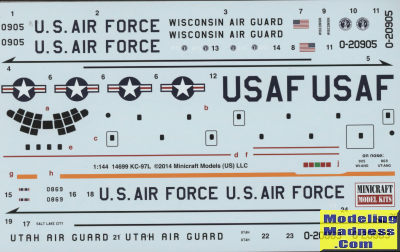
Minicraft 1/144 KC-97L
| KIT #: | 14699 |
| PRICE: | $23.14 on sale |
| DECALS: | Two options |
| REVIEWER: | Scott Van Aken |
| NOTES: | 2014 Updated kit |

| HISTORY |
The USAF began operating the KC-97 in 1950. It purchased a total of 811 KC-97s from Boeing,[as opposed to only 74 of the C-97 cargo version. The KC-97 carried aviation gasoline for its own piston engines but it carried jet fuel for its refueling mission, this required an independent system for each type of fuel. However, it was able to offload its aviation gas to a receiver in an emergency in a procedure known as a "SAVE".
These tankers were vitally important to the world-wide Boeing B-47 Stratojet strategic operations. An example was the support of Arctic reconnaissance flights from Thule Air Base.
While it was an effective tanker, the KC-97's slow speed and low operational altitude complicated refueling operations with jet aircraft. B-52s typically lowered their flaps and rear landing gear to slow the aircraft enough to refuel from the KC-97. In addition, a typical B-52 refueling engagement profile would involve a descent that allowed the aircraft pair to maintain a higher airspeed (220–240 knots). In the early 1960s, the Tactical Air Command added General Electric J47 jet pods from retired KB-50 aerial tankers to produce the KC-97L. These jet pods increased the speed of the KC-97 (for short periods of time) and made it more compatible with jet fighter planes like the F-84, F-100, and F-101.
In 1956, the Strategic Air Command began phasing out its KC-97s in favor of the KC-135 Stratotanker. KC-97s continued flying with Tactical Air Command, the Air Force Reserve, and the Air National Guard. The rest of the KC-97s were retired completely in 1978, when the Texas Air National Guard and the Utah Air National Guard exchanged their KC-97Ls for the C-130 Hercules and the KC-135 Stratotanker, respectively.
| THE KIT |
 This
kit is based on Minicraft's B.377 airliner and later KC-97G. It is one of their
first generation of self-produced kits and is, well, not up to modern standards.
The engraved panel lines are quite soft and equally large. Probably the biggest
downside of the kit was the rather crudely done engine nacelles and a total lack
of any engine detail, there being a simply plastic plate on which to attach the
props.
This
kit is based on Minicraft's B.377 airliner and later KC-97G. It is one of their
first generation of self-produced kits and is, well, not up to modern standards.
The engraved panel lines are quite soft and equally large. Probably the biggest
downside of the kit was the rather crudely done engine nacelles and a total lack
of any engine detail, there being a simply plastic plate on which to attach the
props.
Those who mis-interpret the box statements of 'new engine tooling' will be disappointed to learn this just means the addition of a sprue for the wing mounted jet engines. The other addition to that sprue are the two fairly large upper fuselage radomes.
There is no cockpit detail, which not an issue for most of us in this scale. 1/2 ounce of weight is needed, which is quite a bit. Before closing the fuselage halves, the holes for the upper radomes need to be opened. The wings are an upper and lower half to which the two piece lower engine nacelles are attached. One also attaches the engine pod assemblies at this time. It is only then that the wings are attached.
Next step is to attach the wings, tailplanes forward radome and the clear cockpit piece. Then the landing gear. Personally, I'd hold off on the gear until after painting. For those concerned about weight, I believe Scale Aircraft Conversions do metal gear for this. The boom and crew housing module are then glued in place. Only now are the engines and props attached. At one time, Cobra Company did a set of replacement engines so if you can find one, grab it. There is no gear up option, though it should be easy enough for most modelers if you have a stand.
 Instructions
are straightforward with well drawn construction steps. Generic paint
information is provided through the build process. Markings are for two very
similar aircraft. The box art aircraft is one with the Utah ANG in the last year
of operations. It has a white top above the cockpit section to help reflect
heat. On the underside you will need to paint the black stripes on the forward
fuselage. This plane has a white forward and upper radome. The other aircraft is
with the Wisconsin ANG in 1973 and differs only with the forward radome being
black and the upper half of the upper one in black as well. It also has no white
above the cockpit. The lower surfaces of this plane are in ADC grey, a fairly
common practice. Both planes are mostly bare aluminum. Decals are nicely printed
and provide decals for the windows.
Instructions
are straightforward with well drawn construction steps. Generic paint
information is provided through the build process. Markings are for two very
similar aircraft. The box art aircraft is one with the Utah ANG in the last year
of operations. It has a white top above the cockpit section to help reflect
heat. On the underside you will need to paint the black stripes on the forward
fuselage. This plane has a white forward and upper radome. The other aircraft is
with the Wisconsin ANG in 1973 and differs only with the forward radome being
black and the upper half of the upper one in black as well. It also has no white
above the cockpit. The lower surfaces of this plane are in ADC grey, a fairly
common practice. Both planes are mostly bare aluminum. Decals are nicely printed
and provide decals for the windows.
| CONCLUSIONS |
First off, it is nice to have the later version kitted, even if, according to wiki, only 81 were converted from the G model. I guess I should have expected no improvement over the initial molding of the 377, but there was a glimmer of hope with the 'new engine' on the box top. If all you want is a KC-97 kit, get the G boxing as you can find it for half the price. For those who might want markings for a different unit, there is the Caracal Models sheet that offers another half dozen ANG options. Barring fit issues (and I've not built any of Mincraft's variants of this airplane), it should take longer to paint than to assemble.
| REFERENCES |
https://en.wikipedia.org/wiki/Boeing_KC-97_Stratofreighter
May 2019
Copyright ModelingMadness.com. All rights reserved.
If you would like your product reviewed fairly and fairly quickly, please contact the editor or see other details in the Note to Contributors.
Back to the Main Page Back to the Review Index Page Back to the Previews Index Page